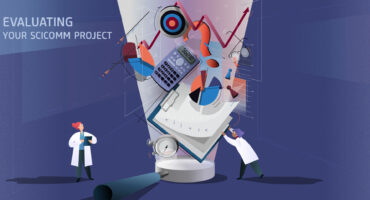What is Horizon Europe and how can you apply for it
An overview of EU's €95.5 billion funding programme for research and innovation.
written by Antónia Ribeiro for one and a half


We make animations, motion graphics and illustrations for your audio-visual communication needs.
Phone: +357 99 658134
Email: info@theoneandahalf.com
One And a Half
28 General Timayia Avenue Kyriakos Building - Block A - Office 301 Larnaca, Larnaca, 6046
Horizon Europe is the European Union (EU)’s solution for research and innovation funding. Once upon a time, the European Commission had unending funding programmes, heavy on bureaucracy.
In 2014, a ground-breaking common strategic framework - hosting all the previous funding - was born. Horizon 2020 not only offered well-rounded funding opportunities but also donned the highest budget of the framework programmes.
Although it has now ended, Horizon 2020 is being continued and improved through Horizon Europe, up until 2027. With an unheard budget of 95.5 billion euros, it focuses on the United Nations Sustainable Development Goals (SDGs) and fighting climate change, all while boosting the EU’s growth.
The new program prioritizes the fight against climate change and projects working towards sustainable development.
Learning with Horizon 2020 highs and lows, Horizon Europe maintained its 3 pillar structure. It adapted, however, to further promote knowledge share and technology transfer.
According to the European Commission, its main goals are:
“
The pillars of the framework are basically the different modalities of funding a person or entity can apply for. Each pillar has a core goal and they are all linked by a common thread (or a horizontal activity, as it is called) - widening participation in European research and improving the European Research and Innovation system (R&I).
One of the main changes in Horizon Europe is the push towards Open Science. Every publication or result coming out of a project funded by the framework needs to be accessible by anyone.
There is also a big push towards international cooperation in projects. Interdisciplinarity and complementarity between partner institutions are essential for the approval of any proposal, with a mix of private and public entities being highly valued.
The new framework also makes a point of gender equality, so push for representation when choosing partners and collaborators.
All this considered, what are the three pillars of Horizon Europe, and what do they mean for someone looking to apply for funding?
This pillar funds frontier research, usually associated with high costs and high risk.
European Research Council (ERC) - funding opportunities for researchers with innovative ideas but with no resources to develop them.
Marie Skłodowska-Curie Actions - funding new researchers to spread their knowledge and gain new skills throughout Europe. If you are doing your PhD or searching for a post-doc opportunity you should look into these actions.
Research infrastructures - promoting a network of structures to ensure that researchers have access to all the resources necessary to pursue their projects. If you need fancy equipment that your lab cannot provide, this action can open the right door for you.
The second pillar focuses on 6 different topic clusters and adds a novel research centre to support policymaking.
Independently of the cluster your project fits into, the proposal should emphasize how it complies with EU policies and SDGs (Sustainable Development Goals).
The clusters are:
The Joint Research Centre (JCR) acknowledges the importance of soundproof scientific knowledge for creating and evaluating public policies. As such, it provides independent research on the EU policy priorities.
Inside this pillar, the European Commission included five missions to give direction to proposals. These missions are topics with a real effect on citizens lives and each one can be inserted in one or more of the clusters. They are an effort to improve R&I. The missions are:
Supporting innovative research discoveries, this pillar focuses on spreading new knowledge towards the fields that need it.
European Innovation Council (EIC) - to support innovations too risky for private investors. You are sitting on an incredible finding that could change your field but the chances of success don’t convince an investor with a heavy pocket? The EIC was created for you.
European Innovation ecosystems - a network for actors driving innovation at a regional and national level.
European Institute of Innovation and Technology (EIT) - educators, entrepreneurs and researchers work together towards new practices and approaches
The first step to apply for funding is to understand what pillar you are applying to.
Albeit an avalanche of information, when broken down the application project is not the monstrous task initially thought out to be.
First, go to the funding page:
https://ec.europa.eu/info/funding-tenders/opportunities/portal/screen/programmes/horizon
Select the actions you want to apply to and look for the open calls available to you. Once you know the programme you are applying to, you just need to follow the directions on the platform.
A bit of advice before starting:
In practical terms, Horizons Europe doesn’t differ that much from Horizons 2020. Dr Edward Duca, a Science Communication Lecturer at the University of Malta, has led his fair share of Horizons 2020 projects between 2014 and 2020. His experience with Horizons Europe so far makes him optimistic for the next 7 years.
With the integration of Responsible Research and Innovation (RRI) through all the pillars of the framework, he worries about the delivery of this goal. Will RRI be properly carried out or is it now only a box to tick in the European Commission’s extensive list?
He hopes that RRI will not be forgotten in the midst of all the innovation and sharing. He also looks forward to quicker funding. In past years, projects had to be planned before funding was approved, otherwise, they wouldn’t be feasible.
In a world of constant innovation and competitive funding, researchers need to think of new ways to make their work shine. They also need time to carry out these exciting ideas. Dr Duca points out how important collaboration between researchers and experts in communication is.
“I like the idea of researchers outsourcing. But they still need to be involved in the process.”
He has experienced the great contributions that animation can bring to researchers' work, for both communication and co-creation purposes. He believes that besides a competitive edge, this form of original outputs is a bonus in the project evaluator’s book.
So you have big ideas and a project to create. Why not sprinkle a bit of animation and give your project an extra edge?
Read more on how Animation can help your Horizon Europe project
At one and a half, we are passionate about research communications and getting your findings seen.
If you are curious about how your research project can benefit from animation, contact us today for a free consultation at info@theoneandahalf.com OR here.
Illustrations and infographics by Christina Kalli.
Written by Antónia Ribeiro
Antónia was a Biologist, once upon a time. She transitioned from the glamorous world of lab benches and international conferences to her one true love - Science Communication.
Portuguese by birth, Antónia is based in Malta. Besides being a freelance science writer, she works as a Social Media Manager for a research magazine and manages an Erasmus+ project for strategic partnerships.
Antónia has a Bachelor in Biology and a Master’s in Biomedical Research from the University of Coimbra, in Portugal. In her free time, she pets street cats and educates people on Portuguese gastronomy - often against their will.
You can find her on Linkedin.


